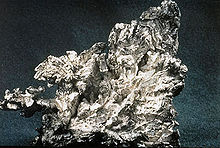History of silver mining
Silver has been known since ancient times. It is mentioned in the Book of Genesis, and slag heaps found in Asia Minor and on the islands of the Aegean Sea indicate that silver was being separated from lead as early as the 4th millennium BCE. The silver mines at Laurium were very rich and helped provide a currency for the economy of Ancient Athens. It involved mining the ore in underground galleries, washing the ores and smelting it to produce the metal. Elaborate washing tables still exist at the site using rain water held in cisterns and collected during the winter months.Extraction of silver from lead ore was widespread in Roman Britain as a result of Roman mining very soon after the conquest of the first century AD.
From the mid-15th century silver began to be extracted from copper ores in massive quantities using the Liquation process creating a boost to the mining and metallurgy industries of Central Europe.
Europeans found a huge amount of silver in the New World in the now Mexican State of Zacatecas (discovered in 1546)[1] and Potosí (Bolivia, also discovered in 1546), which triggered a period of inflation in Europe. The conquistador Francisco Pizarro was said to have resorted to having his horses shod with silver horseshoes due to the metal's abundance, in contrast to the relative lack of iron in Peru. Silver, which was extremely valuable in China, became a global commodity, contributing to the rise of the Spanish Empire. The rise and fall of its value affected the world market.
Silver mining was a driving force in the settlement of western North America [2], with major booms for silver and associated minerals (lead, mostly) in the galena ore silver is most commonly found in. Notable silver rushes were in Colorado, Nevada, Cobalt, Ontario, California and the Kootenay region of British Columbia, notably in the Boundary and "Silvery" Slocan. The first major silver ore deposits in the United States were discovered at the Comstock Lode in Virginia City, Nevada, in 1859.
[edit] Areas of silver mining
Silver is found in native form very rarely as nuggets, but more usually combined with sulfur, arsenic, antimony, or chlorine and in various ores such as argentite (Ag2S) and chlorargyrite ("horn silver," AgCl).The principal sources of silver are copper, copper-nickel, gold, lead, and lead-zinc ores obtained from Canada, (such as Cobalt, Ontario); Mexico (such as Batopilas); Peru; Bolivia; Australia; and the United States.
Mexico is the world's second largest silver producer after Peru in 2009. According to the Secretary of Economics of Mexico, it produced 80,120,000 troy ounces (2,492 metric tons) in 2000, about 15 percent of the annual production of the world.
According to an Endeavour Silver Corp. report, global mine production of silver in 2007 was 671 million troy ounces.[citation needed]
[edit] Silver ore processing
Silver is commonly extracted from ore by smelting or chemical leaching. Ore treatment by mercury amalgamation, such as in the patio process or pan amalgamation was widely used through the 1800s, but is seldom used today.Silver is also produced during the electrolytic refining of copper and by application of the Parkes process on lead metal obtained from lead ores that contain small amounts of silver. Commercial grade fine silver is at least 99.9 percent pure silver and purities greater than 99.999 percent are available.




0 comments:
Post a Comment